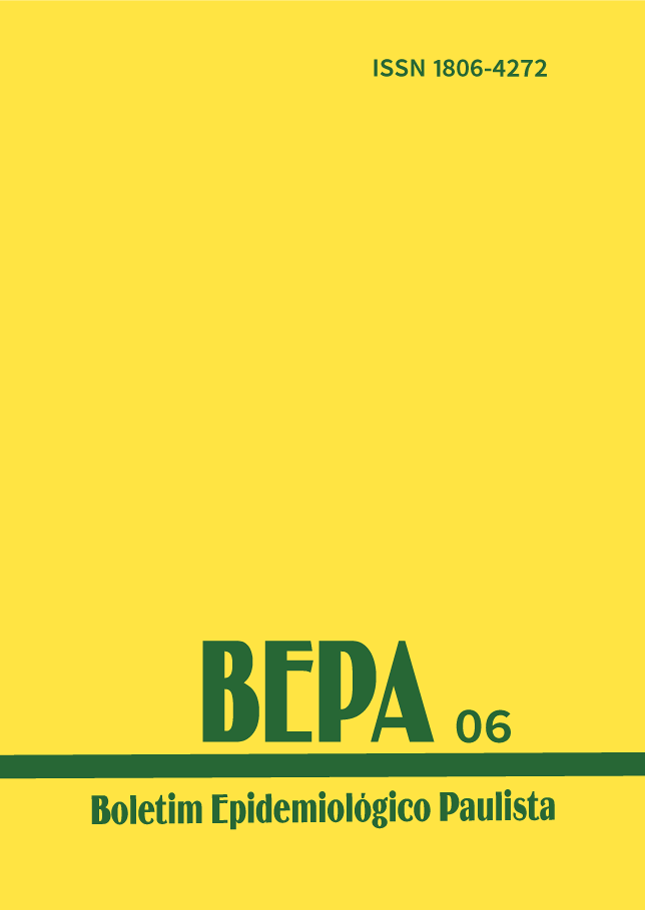Abstract
References
(1) Monteiro ALC; Ruiz EAC; Paz RB. Recomendações e condutas após exposição ocupacional de profissionais de saúde. Boletim Epidemiológico – CRT/Aids – CVE, Ano XVII, nº1, jul.1999.
(2) Association for Professionals in Infection Control and Epidemilogy. APIC position paper: prevention of devicemediated boodborne infections to health care workers. Am J Infect Control 1998; 26(6): 578-80.
(3) Beltrani et al. EM et al. Risck and management of bloodborne infetions in health care workers. Clin Microl Rev 2000; 23:345-8.
(4) Centers for Disease Control and Prevention – CDC – Update US: Public health service guidelines for managemente of occupational exposures to HBV, HCV and HIV and recommendations for postexposure profhylaxis. MMWR 2001; 50:1-52.
(5) Cardo DM et al. A case-control study of HIV seroconversion in health care workers after percutaneous exposure. New Engl Med 1997; 337(21): 1485-90.
(6) Bell DM. Occupatinal risk of human immunodeficiency virus infection in healthcare workers: na overview. Am J Med 1997;102 (suppl 5B): 9-15.
(7) Ippolito G, et al. The risk of ocuppational human immnodeficiency virus in health care workers. Arch Int Med 1993; 153:1451-8.
(8) Werner BG, Grady GF. Accidental hepatitis-b-surfaceantigen- positive inoculations: use of e antigen to estimate infectivity. Ann Intern Med 1982; 97: 367-9.
(9) Henry K, Campbell S. Needlestick/sharps injuries and HIV exposure among health care workers: national estimates based on a survey of U.S. hospitals. Minn Med 1995; 78:41–44.
(10) National Institute for Ocupational Safety and Health (NIOSH): Alert – Preventing Needlestick Injuries in Health Care Settings 2000 nº 108:2-4.
(11) Destra AS et al. Avaliação da subnotificação de acidentes profissionais com material biológico em um hospital universitário – Fase III Anais ABIH, 2002.
(12) Neves SMFM; Souza, CTV de. Perfil dos Profissionais da Área da Saúde Acidentados com Material Biológico Contaminado com HIV Anais ABIH, 1996.
(13) Varkulja GF et al. Abandono de seguimento de acidentes com exposição a fluidos biológicos: análise de fatores de risco e do impacto de dois métodos de convocação Anais ABIH 2002.
(14) Beekmann SE, et al. Hospital bloodborne pathogens programs: program characteristics and blood and body fluid exposure rates. Infect Control Hosp Epidemiol 2001;22(2): 73-82.
(15) Girianelli VR, Rietra RCP. Adesão ao programa de prevenção de acidente com Material biológico Anais ABIH, 2002.
(16) Brasil P. et al. Atuação da CCIH contribuindo para a diminuição do número de acidentes com material microbiológico em um hospital geral da rede federal Anais ABIH, 2002.
(17) Bernal SBB; Ribeiro SL; Fortaleza CMCB. Acidentes com risco biológico por categoria profissional e área de trabalho no hospital MÁRIO GATTI (CAMPINAS, SP). Anais ABIH, 2002.
(18) Trim JC, Elliott TSJ. A review of sharps injuries and preventive strategies. Journal of Hospital Infection 2003 53:237-242.
(19) Reddy SG, Emery RJ. Assessing the effect of long-term availability of engineering controls on needlestick injuries among health care workers: A 3-year preimplementation and postimpleplemntation comparison. Am J Infect Control 2001; 29:425-7.
(20) Cookson Stet al. Increased Bloodstream Infection Rates in Surgical Patients Associated with Variation from Recommended Use and Care Following Implementation of a Needleless Device. Infect. Control Hosp. Epidemiol. 19:23-27. 1998.
(21) Shields JW. Patient versus healthcare worker risks in needleless infusion systems. Inf. Control Hosp. Epidemiol. 19: 86-7, 1998.
(22) L’Ecuyer & Fraser, V.J. Needleless intravenous systems. Inf. Control Hosp. Epidemiol. 18: 536-537. 1997.

This work is licensed under a Creative Commons Attribution 4.0 International License.
Copyright (c) 2004 Silvia Janice Gomes Sassi, Regia Damous F. Feijó
